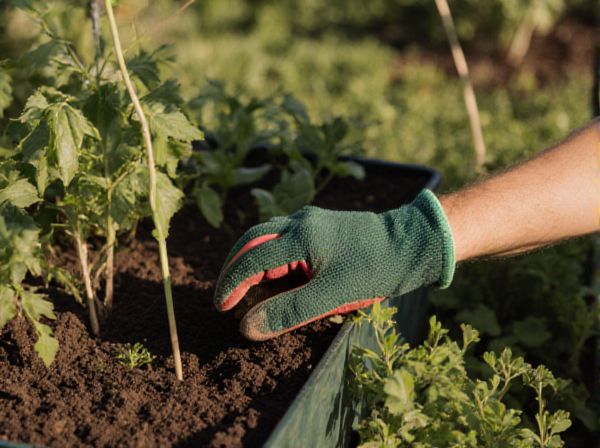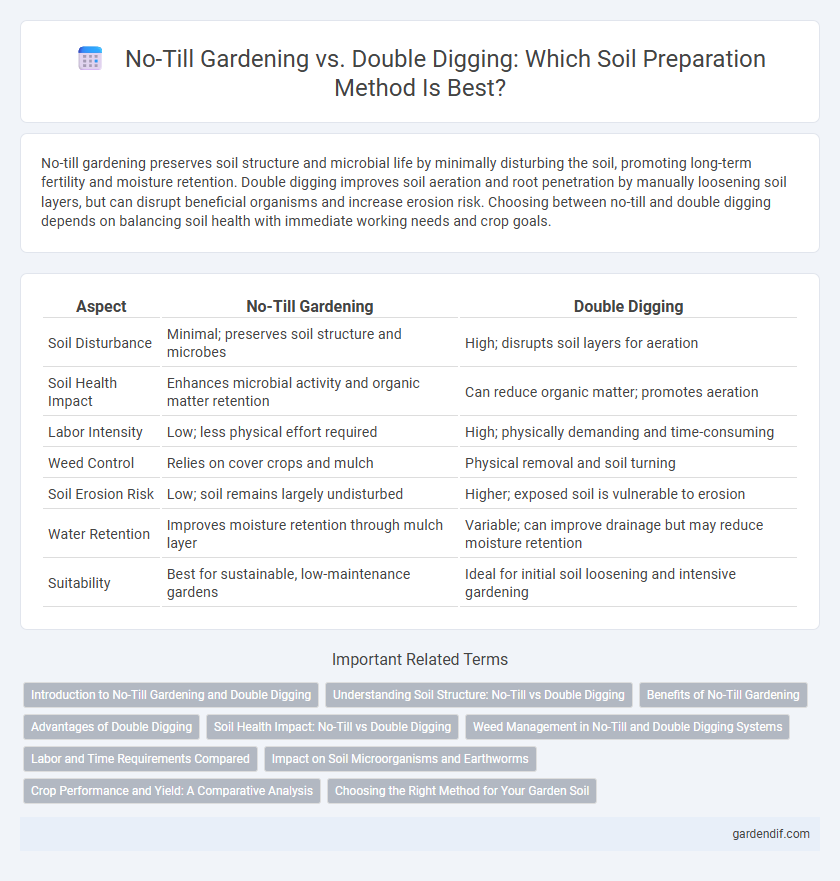
No-till gardening vs Double digging Illustration
No-till gardening preserves soil structure and microbial life by minimally disturbing the soil, promoting long-term fertility and moisture retention. Double digging improves soil aeration and root penetration by manually loosening soil layers, but can disrupt beneficial organisms and increase erosion risk. Choosing between no-till and double digging depends on balancing soil health with immediate working needs and crop goals.
Table of Comparison
| Aspect | No-Till Gardening | Double Digging |
|---|---|---|
| Soil Disturbance | Minimal; preserves soil structure and microbes | High; disrupts soil layers for aeration |
| Soil Health Impact | Enhances microbial activity and organic matter retention | Can reduce organic matter; promotes aeration |
| Labor Intensity | Low; less physical effort required | High; physically demanding and time-consuming |
| Weed Control | Relies on cover crops and mulch | Physical removal and soil turning |
| Soil Erosion Risk | Low; soil remains largely undisturbed | Higher; exposed soil is vulnerable to erosion |
| Water Retention | Improves moisture retention through mulch layer | Variable; can improve drainage but may reduce moisture retention |
| Suitability | Best for sustainable, low-maintenance gardens | Ideal for initial soil loosening and intensive gardening |
Introduction to No-Till Gardening and Double Digging
No-till gardening preserves soil structure by minimizing disturbance, enhancing microbial activity, and reducing erosion, making it an eco-friendly alternative to traditional soil cultivation. Double digging involves manually loosening two layers of soil to improve aeration, root penetration, and drainage but can disrupt soil organisms and increase oxidation. Comparing both methods reveals no-till gardening supports long-term soil health, while double digging offers immediate improvement in soil texture and nutrient availability.
Understanding Soil Structure: No-Till vs Double Digging
No-till gardening preserves soil structure by minimizing disturbance, maintaining organic matter, and promoting beneficial microbial activity, which enhances soil aeration and moisture retention. Double digging disrupts the soil deeply, improving aeration and root penetration but can lead to loss of soil organisms and organic layers if done excessively. Understanding these impacts enables gardeners to choose methods that balance soil health with crop productivity.
Benefits of No-Till Gardening
No-till gardening preserves soil structure by minimizing disturbance, which enhances water retention and promotes beneficial microbial activity. This method reduces soil erosion and compaction, leading to healthier root systems and increased nutrient availability. Compared to double digging, no-till gardening requires less labor and maintains long-term soil fertility through natural organic matter accumulation.
Advantages of Double Digging
Double digging aerates the soil deeply, enhancing root penetration and improving water drainage for healthier plant growth. This technique increases soil fertility by incorporating organic matter more thoroughly, boosting nutrient availability. It also promotes better soil structure and microbial activity, leading to a more sustainable and productive garden environment.
Soil Health Impact: No-Till vs Double Digging
No-till gardening preserves soil structure by minimizing disturbance, which promotes beneficial microbial activity and reduces erosion, enhancing long-term soil health. Double digging aerates the soil deeply, improving root penetration and nutrient availability but can disrupt soil organisms and increase oxidation, potentially leading to organic matter loss. Both methods impact soil health distinctly, with no-till favoring soil ecosystem stability and double digging enhancing immediate soil fertility.
Weed Management in No-Till and Double Digging Systems
No-till gardening suppresses weed growth by maintaining soil cover and minimizing disturbance, which preserves weed seed burial and enhances microbial activity that competes with weeds. Double digging aerates soil deeply, physically disrupting weed roots and seedlings while incorporating organic matter that improves soil structure and fertility, but it can also bring dormant weed seeds to the surface, increasing weed pressure. Weed management effectiveness depends on the balance between soil disturbance and cover maintenance, with no-till systems favoring biological suppression and double digging relying on mechanical control.
Labor and Time Requirements Compared
No-till gardening significantly reduces labor and time requirements by eliminating the need for deep soil disturbance, preserving soil structure and microbial life. In contrast, double digging is labor-intensive and time-consuming, involving the manual turning and aeration of soil to improve drainage and root penetration. No-till methods enable quicker planting cycles and less physical strain, making it a more efficient choice for sustainable gardening.
Impact on Soil Microorganisms and Earthworms
No-till gardening preserves soil structure and promotes a diverse ecosystem of soil microorganisms and earthworms by minimizing disturbance, enhancing microbial activity and organic matter retention. Double digging disrupts soil layers, temporarily boosting aeration but potentially damaging earthworm habitats and decreasing microbial diversity due to soil turnover. Studies show no-till methods increase beneficial microbial populations and earthworm density, crucial for nutrient cycling and soil fertility.
Crop Performance and Yield: A Comparative Analysis
No-till gardening preserves soil structure and moisture, promoting microbial activity that enhances nutrient availability, which often results in improved crop performance and steady yields over time. In contrast, double digging aerates the soil deeply, facilitating root penetration and initial nutrient access, potentially boosting early crop growth but risking disruption of soil ecosystems. Studies indicate no-till systems tend to sustain higher long-term yields and soil health, while double digging may produce short-term yield spikes at the expense of soil stability.
Choosing the Right Method for Your Garden Soil
No-till gardening preserves soil structure and enhances microbial activity by minimizing disturbance, ideal for maintaining organic matter in healthy soils. Double digging improves aeration and drainage by deeply loosening compacted soil, making it suitable for heavy clay soils or new garden beds. Selecting the right method depends on soil composition, garden goals, and labor availability, ensuring optimal plant growth and soil health.
No-till gardening vs Double digging Infographic

 gardendif.com
gardendif.com